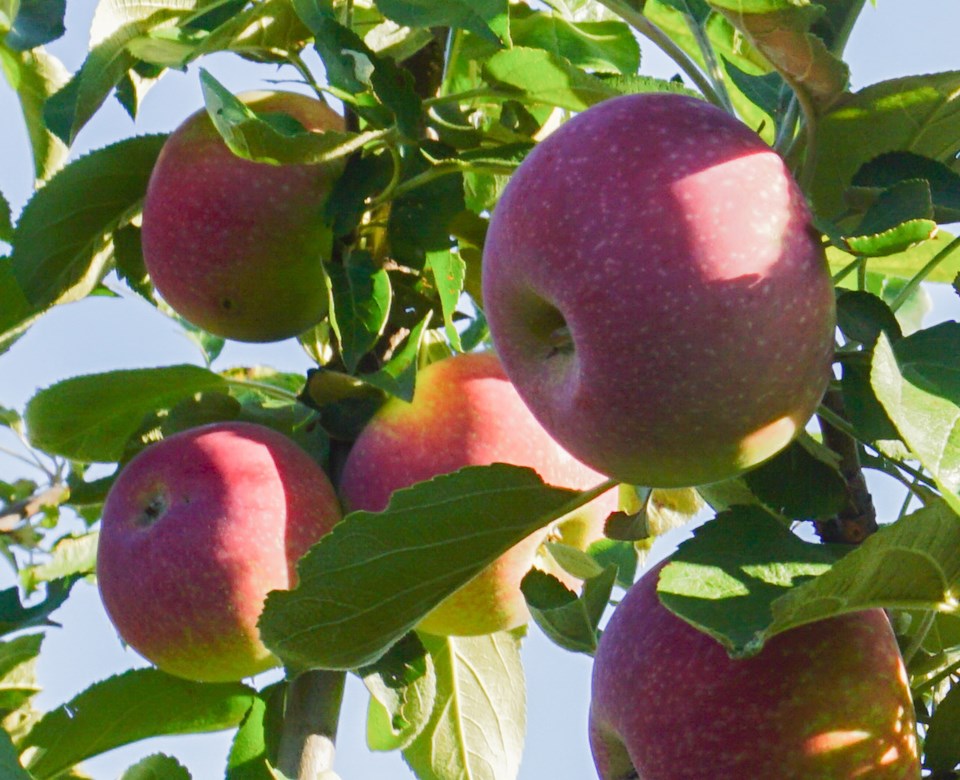Apples (Malus pumila) have been part of our prairie landscape almost since the time of European settlement with early immigrants bringing seeds from Europe and Russia. Apples are descendants of M. sieversii, native to the Kazakhstan mountains and taken to Macedonia in 328 BCE by Alexander the Great. Prairie plant breeders have done an admirable job of breeding hardy, high quality apples for well over a century – trees hardy enough to survive prairie winters were crossed with better quality apples from eastern Canada and Minnesota. The University of Saskatchewan fruit breeding program, under Dr. Bob Bors, continues to introduce high quality apples hardy to -40°C.
Prairie apple trees generally live for 30+ years before declining; with proper care they can last much longer. Apples are self-incompatible: two varieties are needed for cross-pollination. Ornamental crab apples can also pollinate eating varieties. In city gardens, having a single apple tree is not a problem where another tree is usually within bee-flying distance (e.g. in your neighbour’s yard). But in rural areas, plant two different varieties. All apples tend to bloom at the same time and most bloom after danger of frost.
Apples are grafted onto hardy rootstock, generally Siberian crabapple stock. Trees are up to 20 feet in height and should be spaced 13 feet apart. Apple trees labeled as “dwarf” have been grafted onto dwarf rootstock, usually “Ottawa 3” in zone 2. The dwarf rootstock reduces the height of the trees to about 10 feet (3 m), making them easier to prune, thin and pick. No ladders needed! Dwarf rootstock does not affect the size of the fruit. And dwarf trees begin bearing at three years of age as opposed to five years for standard trees. Dwarf apple trees should be staked because the top portion tends to grow more vigorously than the rootstock can easily support. If unsupported, they may fall over or break off. Use a heavy-duty metal or wooden fence post.
Plant apple trees in well-drained soil in full sun. Water them regularly (1 inch per week during the growing season; more in sandy soil, less in clay), especially when they are young. Once established, they are fairly drought-tolerant but benefit from irrigation during hot dry periods.
Fertilize moderately in early spring with compost, well-rotted manure or alfalfa pellets. Reduce fertilizer if winterkill or fire blight occurs. Prune off infected branches. Young trees will grow much faster without grass competition so give them at least a 3-foot diameter circle of mulch. Mulch with post peelings, weed-free straw, grass clipping, chipper debris or flax shives to retain moisture, add organic matter to the soil, moderate soil temperature and reduce weeds.
Apple trees are known for “biennial bearing” – producing so much fruit in one year that they lack sufficient nutrients and sugars to create flower buds (and fruit) the following year. In abundant years, branches may crack and break under the heavy fruit load. This cycle can be avoided by pruning and fruit thinning. Apples are formed on short branches called spurs that can produce for a decade or more. A few weeks after flowering, hundreds of small, immature apples fall. Called “June drop”, this can also occur in early July. But further thinning may be required. Use the “One Hand Rule”: spread your fingers and thumb far apart. As you hold your hand up to a branch, allow only one apple to remain in that space. This general rule of thumb (pun intended) assumes an average sized-hand and an average-sized apple. Thinning early in the season results in substantially larger fruit.
Apples in Saskatchewan ripen from mid-August through October depending on the variety. They can tolerate light frosts (-4°C) due in part to their high sugar content. Many of the last to ripen have the longest refrigerator life. The firmer an apple, the longer its storage life.
To learn about apple varieties recommended for prairie gardens, go to the University of Saskatchewan sites: and .
— Sara Williams is the co-author, with Bob Bors, of Growing Fruit in Northern Gardens.
This column is provided courtesy of the Saskatchewan Perennial Society (SPS; [email protected] ). Check our website (www.saskperennial.ca) or Facebook page (www.facebook.com/saskperennial) for a list of upcoming gardening events




